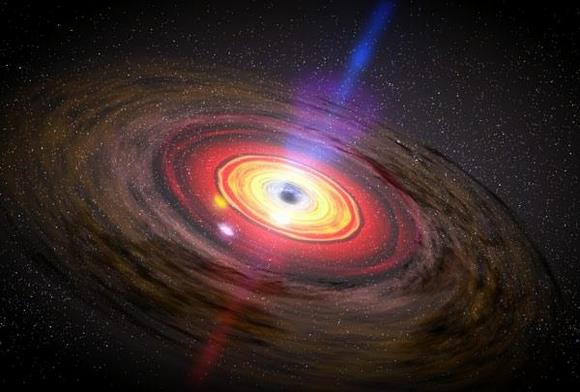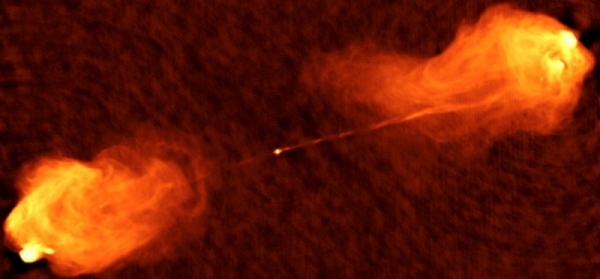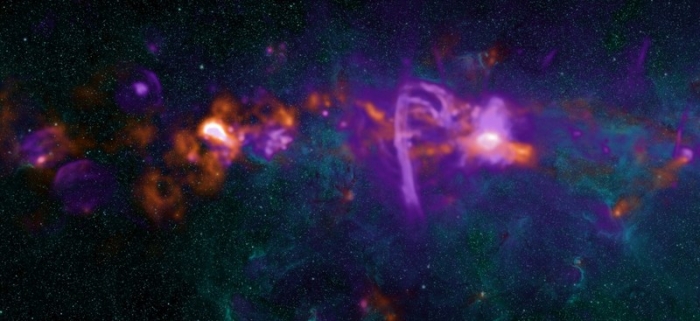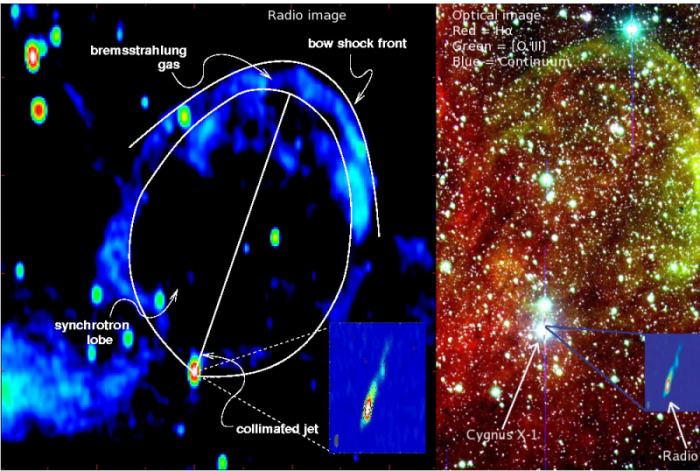E2 : Impact des trous noirs sur leur environnement
Suite aux recommandations du Conseil Scientifique 2013, le projet a été arrêté.
-
-
Position, Sujet Nom Laboratory Grade, employer Initials Photo Responsable, [C] Goldwurm Andrea APC Directeur Recherche, CEA AG Coresponsable, [A] Mirabel Felix AIM Directeur Recherche, CEA FM Membre, [B] Beckmann Volker APC Post-Doc CNRS VB Membre, [D] Chaty Sylvain AIM Professeur, Univ. Paris Diderot SC Membre, [C] Clavel Maica AP PhD Studen MC Membre, [D] Coleiro Alexis AIM PhD Student AC Membre, [B] De Jong Sandra APC PhD Student SDJ Membre, [A] Laurent Philippe APC Directeur Recherche, CEA PL Membre, [B,C] Soldi Simona AIM, APC Post-Doc CNES, CNRS SS Membre, [C] Terrier Regis APC Chargé de recherche, CNRS/IN2P3 RT Membre, web-page man. [C] Trap Guillaume APC Palais de la Decouverte, Collaborateur Scientif. APC et CEA -
PUBLICATIONS mid-2011 – 2013 (in bold publications directly supported by E2)
Books, Monographs, Thesis:
- Beckmann, V. & Shrader, C.R.; Active Galactic Nuclei, 2012, ISBN-13: 978-3527410781. 350 pages. Wiley-VCH Verlag GmbH, 2012
- Ponti, G., Morris, M., Terrier, R., Goldwurm, A.; Traces of past activity in the Galactic Centre. 2013, In Advances in Solid State Physics, Vol. 34, “Cosmic Rays in Star-Forming Environments”, eds. Olaf Reimer and Diego F. Torres, 331 (arXiv:1210.3034)
- Sandra De Jong, Accretion processes of radio galaxies at high energies, University: Observatoire de Paris, Ecole Doctorale Astronomie & Astrophysique d’Ile-de-France, defended 29 October 2013 at FACe/APC Paris Diderot
- Alexis Coleiro, Etude Multilongueur d’onde d’étoiles binaires accrétantes de grande masse, University Paris Diderot, Ecole Doctorale Astronomie & Astrophysique d’Ile-de-France, defended 25 September 2013 at SAp/IRFU/CEA Saclay
Refereed Papers:
- Beckmann, V., et al.; The hard X-ray emission of Centaurus A, 2011, A&A 531, 70
- Bower, G., …, Clavel, M. Goldwurm, A., …, Detection of Variability in the Size of Sagittarius A*, 2013, ApJL, submit.
- Chaty, S., Dubus, G., Raichoor, A.; Near-infrared jet emission in the microquasar XTE J1550-564, 2011, A&A, 529, A3
- Chaty, S., Rahoui, F., Mid-infrared spectroscopy revealing the surroundings of the obscured High Mass X-ray binary IGR J16318-4848, 2012, ApJ, 751, 150
- Chaty, S., Muñoz Arjonilla, A.J., Dubus, G., Infrared study of H1743-322 in outburst: a radio-quiet microquasar, 2013, A&A, submit.
- Clavel, M., Terrier, R., Goldwurm, A., Morris, M., Ponti, G., Soldi, S., Trap, G., Echoes of multiple outbursts of Sagittarius A* revealed by Chandra, 2013, A&A, 558, 32 (arXiv:1307.3954)
- Coleiro, A., Chaty, S., Distribution of High Mass X-ray Binaries in the Milky Way, 2013, ApJ, 764, 185
- Coleiro, A., Chaty, S., et al., Infrared identification of high-mass X-ray binaries discovered by INTEGRAL, 2013, A&A, in press (arXiv:1013.0451)
- Curran, P.A., Chaty, S., Zurita Heras, J.A.; Disentangling the nIR/optical emission of black hole XTE J1650-500 during outburst, 2012, A&A, 547, 41
- Curran, P.A., Chaty, S., Near-infrared and optical observations of the failed outbursts of black hole XTE J1550-564, 2013, A&A, 557, 45
- de Jong, S., Beckmann, V., Mattana, F.; The nature of the multi-wavelength emission of 3C 111, 2012, A&A 545, 90
- Dodds-Eden, K., .., Goldwurm, A., .., Trap, G., et al.; The Two States of Sgr A* in the Near-infrared: Bright Episodic Flares on Top of Low-level Continuous Variability, 2011, ApJ, 728, 37
- Dogiel, V. A., Chernyshov, D. O., Tatischeff, V., Cheng, K.-S., Terrier, R.; The Origin of the 6.4 keV Line Emission and H2 Ionization in the Diffuse Molecular Gas of the Galactic Center Region, 2013, ApJ, 771, L43
- Melia, F., Falanga, M., Goldwurm, A.; Polarimetric imaging of Sgr A* in its flaring state, 2012, MNRAS, 419, 2489
- Mirabel, I. F., Dijkstra, M., Laurent, P., Loeb, A., Pritchard, J. R.; Stellar black holes at the dawn of the universe, 2011, A&A 528, 149
- Soldi, S., Beckmann, S., Baumgartner, W.H., Ponti, G., Shrader, C.R., Lubinski, P., Krimm, H.A., Mattana, F., Tueller, J., Long-term variability of AGN at hard X-rays, 2013, A&A, in press (arXiv:1311.4164)
- Trap, G., Goldwurm, A., et al.; Concurrent X-ray, near-infrared, sub-millimeter, and GeV gamma-ray observations of Sagittarius A*, 2011, A&A, 528, 140
- Zurita Heras, J. A., Chaty, S., Cadolle-Bel, M., Prat, L.; Evidence of an irradiated accrétion disc in XTE J1818-245, 2011, MNRAS, 413, 235
Conference Proceedings:
- Beckmann, V., Jean, P., Lubiński, P., Soldi, S., Terrier, R.; The dominant emission process of the X-ray spectrum of Cen A, 2011, Proc. of the Conf. “The X-ray Universe”, Berlin 2011, id 34
- Beckmann, V., De Jong, S., Mattana, F., Saez, D., Soldi, S.; Gamma-ay emitting radio galaxies at hard X-rays: Seyfert core or jet emission ? ; 2013, PoS INTEGRAL 2012, id 058
- Beckmann, V., Shrader, C.; The AGN phenomenon: open issues; 2013, PoS INTEGRAL 2012, id69
- Clavel, M., Terrier, R., Goldwurm, A., Morris, M., Ponti, G., Soldi, S., Trap, G.; Chandra observations of the X-ray emission from Molecular Clouds at the Galactic Center related to Sgr A* past activity; 2013, PoS INTEGRAL 2012, id 106
- Clavel, M., Terrier, R., Goldwurm, A., Morris, M., Ponti, G., Soldi, S., Trap, G.; The reflection of two past outbursts of Sagittarius A* observed by Chandra during the last decade, 2013, Conf. Proc of IAU 303 Symp. “The Galactic Center: Feeding and Feedback in a Normal Galactic Nucleus”, 30/9-4/10/2013, Santa Fe, NM, USA, submit.
- Coleiro, A., Chaty, S., Zurita Heras, J.A., Rahoui, F., Tomsick, J.A., Identification of 12 High Mass X-Ray Binaries detected by INTEGRAL through NIR photometry and spectroscopy2013, PoS INTEGRAL 2012, id
- de Jong, S., Beckmann, V.; The non-thermal core of 3C 111, 2011, Proc. of the Conf. “The X-ray Universe”, Berlin 2011, id 309
- de Jong, S., Beckmann, V., Soldi, S., et al.; M87 in hard X-rays: an INTEGRAL view; 2013, PoS INTEGRAL 2012, id 070
- de Jong, S., Beckmann, V., Mattana, F.; The non-thermal core of 3C 111, 2012, Proceedings of Science, SISSA, PoS(Extremesky 2011) 076.
- Mirabel, I. F.; Stellar black holes: Cosmic history and feedback at the dawn of the universe, 2011, IAU Symp., 275, 3 (arXiv:1012.4944)
- Menzel, M.L., Beckmann, V., Mattana, F.; AGN emission processes of NGC 4945 in the X-rays and gamma-rays, 2012, Proceedings of Science, SISSA, PoS (Extremesky 2011) 075
- Soldi, S., et al.; AGN variability at hard X-rays, 2011, Proc. of the Conf. “The X-ray Universe”, Berlin 2011, id 154
- Soldi, S., et al.; High-energy emission from NGC 5506, the brightest hard X-ray Narrow Line Seyfert 1 galaxy, 2011, Proc. of the Conf. “NLS1 Galaxies and their place in the Universe”, Milan 2011
- Soldi, S., Baumgartner, W., Beckmann, V., et al.; AGN variability at hard X-rays; 2013, PoS INTEGRAL 2012, id 65
- Soldi, S., Clavel, M., Goldwurm, A., Morris, M., Ponti, G., Terrier, R., Trap, G.; An X-ray survey of the Central Molecular Zone: variability of the Fe Kalpha emission line, 2013, Conf. Proc of IAU 303 Symp. “The Galactic Center: Feeding and Feedback in a Normal Galactic Nucleus”, 30/9-4/10/2013, Santa Fe, NM, USA, submit.
- Soldi, S., Clavel, M., Goldwurm, A., Ponti, G., Terrier, R., Trap, G., Greiner, J., Prinz, T., Rau, A., Servillat, M.; A new Very Faint X-ray Transient in the Galactic centre, 2013, Conf. Proc of IAU 303 Symp. “The Galactic Center: Feeding and Feedback in a Normal Galactic Nucleus”, 30/9-4/10/2013, Santa Fe, NM, USA, submit.
- Trap, G., Ponti, G., Soldi, S., Clavel, G., Terrier M., Goldwurm, A., Thermonuclear bursts from AX J1745.6–‐2901, 2013, Conf. Proc of IAU 303 Symp. “The Galactic Center: Feeding and Feedback in a Normal Galactic Nucleus”, 30/9-4/10/2013, Santa Fe, NM, USA, in preparation
-
28/09/2013 – R1
Echoes of multiple outbursts of Sagittarius A* revealed by Chandra
Using the Chandra X-ray Observatory, a team of scientists led by researchers of the APC laboratory in Paris, and SAp/CEA Saclay, France, has been studying the diffuse X-ray emission coming from a region close to the center of our Galaxy. The rapid and complex variations they observed can only be created by an intense X-ray radiation reflected by the dense molecular clouds of the region. The required radiation can only have been produced by the central supermassive black hole undergoing multiple periods of intense activity in the past. The paper reporting these results has been published in Astronomy and Astrophysics (Clavel, M., Terrier, R., Goldwurm, A., Morris, M., Ponti, G., Soldi, S., Trap, G., 2013, A&A, 558, A32, arXiv:1307.3954) and it is one of the highlights of the A&A 2013 October volume.
Sagittarius A* is the supermassive black hole at the Galactic center. It is located at about 26,000 light years from the sun and is one of the least luminous known supermassive black holes of the Universe. Nevertheless, there is evidence that this object has been more luminous in the past, between several decades and a few hundreds years ago. This past activity can be studied from the reflection of its X-ray component by the dense molecular clouds surrounding Sagittarius A*. Indeed, it takes longer for the emission to travel from the black hole to the cloud and then from the cloud to us than to come directly from the black hole. Thus, the reflected radiation is reaching the Earth with a delay compared to the direct emission from the illuminating object (which is already seen about 26,000 years after it is emitted) and thus it appears as a light echo of an activity that has been quenched since then. If measured in great detail this echo allows us to study the past behavior of the black hole.
When the high energy radiation hits the cool molecular gas of the cloud it is partly absorbed by the gas and partly scattered away. A fraction of the absorbed radiation is re-emitted as fluorescence light at specific energies corresponding to the difference of the electron energy levels of the atoms involved in the absorption and re-emission processes. One characteristic fluorescent line, which is expected to be particularly intense, is the one corresponding to the first two energy levels of the iron atom at 6.4 keV in the X-ray band. This X-ray line and the associated scattered continuum emission (the so called reflection component) have been indeed observed by the large space X-ray observatories presently in operation, notably the European INTEGRAL and XMM-Newton satellites and the American Chandra observatory. It is emanating from the massive and dense clouds of molecular gas that turn around the center of the Milky Way at distances varying between few tens to thousand light years from it.
This emission was also already observed to vary and even to propagate with an apparent superluminal speed by the same research team back in 2010 using XMM-Newton and was then attributed to the reflection of a long outburst, about 300 years long, from Sagittarius A* (see http://www2.cnrs.fr/presse/communique/1894.htm).
Taking advantage of Chandra exceptional high resolution the team of astrophysicists focused on the bright clouds which are less than 100 light years away from Sagittarius A* in projection towards the Galactic east in order to explore in greater details the drastic variations of the iron line fluorescent emission during the past decade. They found that the observed variations can be described essentially by two different behaviors: either a two-year peak propagating from west to east in one specific molecular structure (called the Bridge) or a linear change, either increasing or a decreasing, for the past ten years in all the other structures. Based on the density of the clouds which are reflecting the past emission of Sagittarius A*, the team concluded that these two behaviors are likely due to two distinct past events of Sagittarius A*.
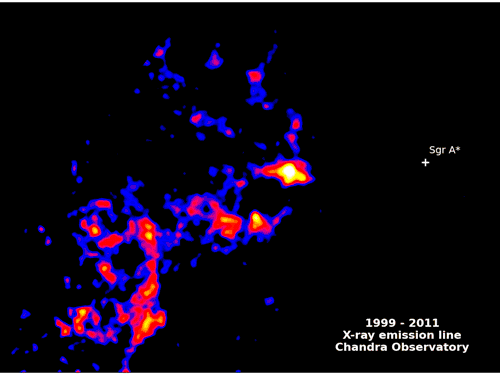
The animation above presents the main results of the publication. The first color image gives a static view of the neutral iron fluorescence line emission at 6.4 keV in the region, as seen by Chandra between 1999 and 2011. Both the position of the supermassive black hole Sagittarius A* (white cross) and the angular scale in light years (ly) are indicated on this image plotted in Galactic coordinates. Then the animation shows that the brightest regions are correlated with molecular materials which are moving at different velocities. In particular three groups of clouds are identified in the radio images of a characteristic molecular line: MC1 & MC2, G0.11-0.11 and The Bridge. The rest of the animation gives a high resolution view of the X-ray variations occurring in these clouds as seen by Chandra. First it shows an overview of the variations with three images corresponding to three different periods. This is also summarized in a composed color image where the emission detected is, between 1999 and 2003 in red, between 2004 and 2007 in green and between 2008 and 2011 in blue. Second, it zooms on the Bridge region showing the two-year peaked variation of this cloud starting in 2008 and propagating from right to left. Third, it zooms on the MC1 & MC2 clouds which have been varying linearly from 1999 to 2011 with also a clear propagation from right to left, away from Sagittarius A*.
The figure below shows a sample of the characteristic lightcurves of the different parts of the molecular clouds, located in the composite color image of the region where the 6.4 keV iron line emission detected between 1999 and 2003 is in red, between 2004 and 2007 in green and between 2008 and 2011 in blue. The plots give the 4 to 8 keV continuum intensity, in units of 10-6 ph cm-2 s-1,measured in 15″-size square regions within the identified molecular clouds, at different years. The two behaviors mentioned above are clearly visible in the lightcurves, with the inset 1) and 2) showing the two-year peak emission propagating along the Bridge and all other plots showing the ten-year linear rises or decays.
This is the first time that such fast variations of the reflection component from the Galactic center molecular clouds, and in particular an event as short as a couple of years seen both in its rising and decaying phase, are reported convincingly. The events at the origin of these two past outbursts are still not understood but these results shed a new light on the behavior of the Galactic supermassive black hole Sagittarius A* and indicate that these and future observations will likely lead soon to a full reconstruction of the past few hundred years history of its activity.
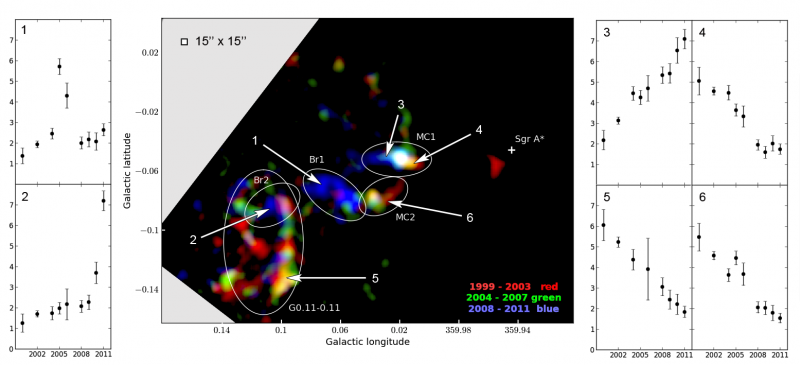
These results will be presented (oral talk) at the IAU 303 Symposium “The Galactic Center: Feeding and Feedback in a Normal Galactic Nucleus”, 30/9 – 4/10/2013 in Santa Fe, NM, USA, by M. Clavel (https://science.nrao.edu/science/meetings/IAU303-GC2013) and will be the subject of a Chandra News release in October 2013 (http://www.nasa.gov/mission_pages/chandra/main/index.html).
Article by: M. Clavel, A. Goldwurm
Team Documents:
- E2 2011-2013 Activity Report submitted to Science Committee: CS 2013 – E2 – V2.pdf
- E2 Preliminary 2013 Budget: E2-Budget2013D-p1.pdf E2-Budget2013D-p2.pdf E2-Budget2013D-p3.pdf
- E2 2011-2013 Activity Report submitted to Science Committee revised version: CS 2013 – E2 – V4.pdf
- Proposal to upgrade the project to AIM-APC Interface Project: InterfaceProject_AIM_APC_BH_v4
Attachment Size CS 2013 – E2 – V2.pdf 353.33 KB E2-Budget2013D-p1.pdf 193.98 KB E2-Budget2013D-p2.pdf 286.15 KB E2-Budget2013D-p3.pdf 293.86 KB cs_2013_-_e2_-_v4.pdf 355.88 KB interfaceproject_aim_apc_bh_v4.pdf 465.2 KB

